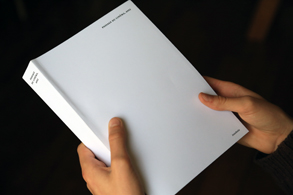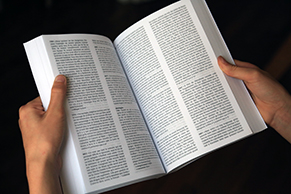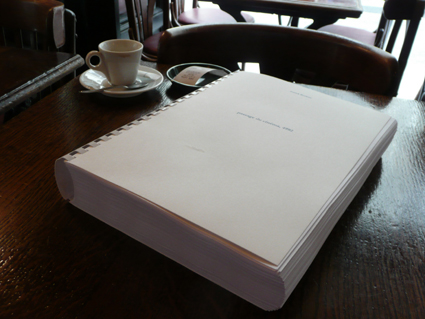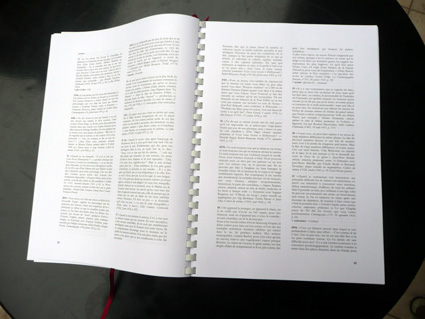First of all, what is it?


Passage du cinéma, 4992
165 x 240 mm. PlanoPak Weiß 50 gr. (Papyrus). 992 pages.
ISBN 978-2-9544708-0-1. 35 euros. Septembre 2013.
Composition, choix des fragments et montage : Annick Bouleau
Conception graphique : Le Théâtre des Opérations
Édition : Ansedonia, association Loi 1901
“the only book to recount the history of cinema” — Jean-Luc Godard, in the English-language pressbook for Goodbye to Language, p. 22
Not simply a book, but an interactive, multimedia art project by French experimental filmmaker and teacher Annick Bouleau (you can go here for her extensive filmography), the centerpiece of which is a book in French, a copy of which Bouleau was kind enough to send to me. (For the many other aspects of this project and her work, one could easily spend days navigating Bouleau’s web site.) It took her a decade to assemble it. [2019: In July 2019, while I was visiting Paris, she recognized me on the street and introduced herself.]
What are the contents of this book (seen below in manuscript form)?
A title page, dedication, acknowledgements, Introduction (“Mode d’emploi”), Table of Contents (an alphabetical listing of hundreds of topics, from “abandon” to “zoom,” with corresponding page numbers), and a one-page reader’s manual (“Vade-mecum du lecteur”), followed by 967 double-column pages of 4992 entries.
What are these entries?
Statements by filmmakers about cinema and related topics, drawn from interviews and other sources taken from all the major, surviving French film magazines and a few books published between 1895 and 2000.
Caveat #1: There are no indexes for filmmakers or authors or publications or dates, only a list of topics in the Table of Contents. (The publications are listed in the Introduction.)
Caveat #2: The book isn’t designed to be read straight through, from pages 18 through 968, but selectively. Cross-references are added at the end of some entries, but only to other topics. Bouleau compares the entries to individual shots in a film and invites readers to make their own montages and do their own editing.
Caveat #3: There are no illustrations in the book, only words.
To suggest (however briefly and inadequately) the sort of riches that can be found in this massive book, let me attempt a mini-montage of my own by roughly paraphrasing (in the first case) or cataloguing (in the second) the contents to be found in just two entries, selected more or less at random:
citation (quotation):
Jean-Luc Godard (in Cinéma 65, mars 1965) maintains that the quotations in his own films are always justified, and then goes on to explain that the quotation of Dreyer’s Passion de Jeanne d’Arc in Vivre sa vie came only after first considering Bresson’s Pickpocket (a film that had come out three years earlier, and exerted an enormous influence on Vivre sa vie), then Cocteau’s Testament d’Orphée. Then he went back to Bresson, who was shooting his own Jeanne d’Arc film at the time. Godard asked if he could include an extract from the new film, and Bresson agreed; finally, Godard changed his mind once again and settled on Dreyer’s Jeanne d’Arc “…without telling Bresson.” (This is cross-referenced with André S. Labarthe’s statement about quotation in reference to his documentary about Abel Gance, the second item under the topic ubiquité.)
François Truffaut (in his “Journal de Fahrenheit 451,” Cahiers du cinéma, février 1966) reports that Universal’s Hollywood lawyers wanted him to burn only books in the public domain rather than titles by Faulkner, Sartre, Genet, Proust, Salinger, and Audiberti. Considering this request absurd, Truffaut then consulted a London lawyer who affirmed that he could burn whatever books and authors he wanted. Truffaut triumphantly declares that there will therefore be as many quotations in Fahrenheit 451 as there are “in all eleven of Jean-Luc’s features combined.”
André Téchiné (interviewed by Pascal Bonitzer and Serge Daney in Cahiers du cinéma, août/septembre 1977) finds the whole notion of “alleged” visual quotation problematical. Take for example a shot or image of children playing on a street: is that a reference to Marnie, M, or Wozzeck? What’s certain is that if he quotes something visually, he doesn’t know “who” he cites, Murnau or Lang or Hitchcock or Welles or Sternberg — he’s no longer citing them successively but alternatively, and if it’s a matter of superimposition, that confuses the whole notation of quotations ….He doesn’t like to hear people speak about quotations in cinema. He’d rather speak about incorporation than quotation. Because quotations imply quotation marks, and in cinema, where there are no inverted commas, what’s a quotation when the actors, the lighting, the framing, and the costumes aren’t the same?
These are followed by an entry from Theo Angelopoulos (from Positif, novembre 1988) about quoting from his own works, two separate entries devoted to Joe Dante -– the first (from an interview with Michael Henry in Positif, juillet/août 1998) about the self-reflexive nature of Gremlins 2 (making fun of “everything,” including sequels, merchandizing, corporate greed, and the parents who disapproved of Gremlins), the second (from the same interview) about the “guerilla-cinema” of Dante’s The Movie Orgy in the 60s –- and a final entry from video artist, filmmaker, and photographer Douglas Gordon, taken from an interview with Christine Van Assche in Art press, mars 2000, about appropriating extracts from films and music in ready-mades.
influence:
Entries reproducing statements by Donald Siegel (Positif, 1965), William Wyler (L’Écran français, 1947), John Frankenheimer (Cahiers du cinéma, 1959), Allan Dawn (Présence du cinéma, 1966), Haskell Wexler (Cinématographe, 1979), George Axelrod (Cahiers du cinéma, 1967), Tsui Hark (Cahiers du cinéma, date omitted), John Woo (HK, 1997), Zhang Yimou (Positif, 1992), Wong Kar-wai (Positif, 1995), Li Pingqian (Positif, 1982), Jean-Pierre Mocky (Midi-minuit fantastique, 1966), François Truffaut (Cahiers du cinéma, 1966), Akira Kurosawa (Cinéma 66, 1966), Angelino Fons (Cahiers du cinéma, 1966), Victor Tourjansky (Cinéa-Ciné pour tous, 1925), Gustavo Dahl (Cahiers du cinéma, 1966), Wim Wenders (Positif, 1977), Jerry Schatzberg (Positif, 1971), Philippe Rousselot (Cahiers du cinéma, 1987), Serge Le Péron (Cahiers du cinéma, 1973), Henri Colpi (Cinématographe, 1982), Raúl Ruiz (Cahiers du cinéma, 1981), Quentin Tarantino (Positif, 1992), Vincent Gallo (Cahiers du cinéma, 1999), Emir Kusturica (Positif, 1993), Satyajit Ray (Cahiers du cinéma, 1966), and Roberto Rossellini (Cahiers du cinéma, 1954). [12/18/14]


